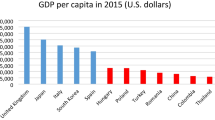Abstract
In today’s global economy, increased international market integration and a steep rise in the number of multinational enterprises have made the notion of there being no international trade bizarre indeed. This paper revises the shift-share analysis by adopting the net export ratio (NX) to separate the domestic and foreign components of regional employment change and to show the revealed comparative advantage of international trade. The result is found that the effects of international trade on employment change are ubiquitous, and its importance therefore cannot be overlooked. As for the significantly positive values of NX and its relative growth, for example, the employment change mainly arises from the international market and not from domestic demand. This modification makes the shift-share analysis more reasonable and sensible, especially in relation to a small open economy.
Similar content being viewed by others
References
Chiang S (2009) Location quotient and trade. Ann Reg Sci 43: 399–414
Dinc M, Haynes KE (1998a) International trade and shift-share analysis: a specification note. Econ Develop Q 12: 337–343
Dinc M, Haynes KE (1998b) International trade and shift-share analysis: a specification note, rejoinder. Econ Develop Q 12: 351–354
Dinc M, Haynes KE (2005) Productivity, international trade and reference area interactions in shift-share analysis: some operational notes. Growth Change 36: 374–394
Haynes KE, Dinc M (1997) Productivity change in manufacturing regions: a multifactor/shift-share approach. Growth Change 28: 201–221
Hoen AR, Oosterhaven J (2006) On the measurement of comparative advantage. Ann Reg Sci 40: 677–691
Loveridge S, Selting AC (1998) A review and comparison of shift-share identities. Int Reg Sci Rev 21: 27–58
Markusen A, Noponen H, Driessen K (1991) International trade, productivity and U.S. regional job growth: a shift-share interpretation. Int Reg Sci Rev 14: 15–39
Noponen H, Markusen A, Driessen K (1997) Trade and American cities: who has the comparative advantage?. Econ Develop Q 11: 67–87
Noponen H, Markusen A, Driessen K (1998) International trade and shift-share analysis: a response to Dinc and Haynes. Econ Develop Q 12: 344–350
Rigby DL, Anderson WP (1993) Employment change, growth and productivity in Canadian manufacturing: an extension and application of shift-share analysis. Can J Reg Sci 16: 69–88
Sihag BS, McDonough CC (1989) Shift-share analysis: the international dimension. Growth Change 20: 80–88
Wadely D, Smith P (2003) Straightening up shift-share analysis. Ann Reg Sci 37: 259–261
Yu R, Cai J, Loke MK, Leung P (2010) Assessing the comparative advantage of Hawaii’s agricultural exports to the US mainland market. Ann Reg Sci 45: 473–485




